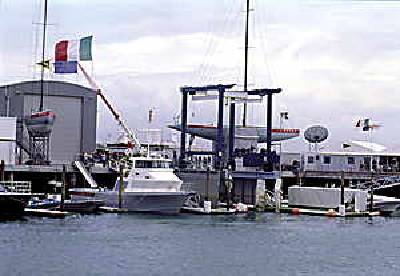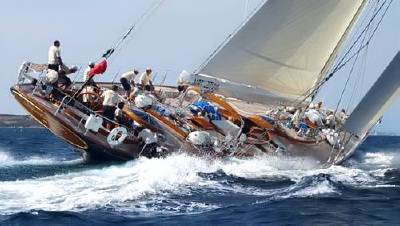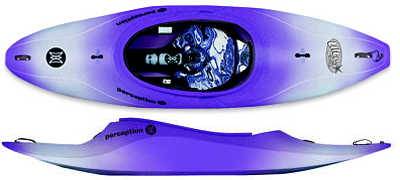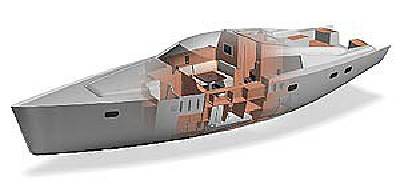The Italian Team Prada challenge to wrest the America’s Cup from the Kiwis was blunted by the sailing skills of the New Zealand defender. However, behind the scenes an untold amount of design and development goes into building any yacht that is good enough to even reach to finals.
When Team Prada finally defeated AmericaOne (5-4) in Auckland, to take the Louis Vuitton Cup, the syndicate earned the right to become the challenger in the America’s Cup finals.
The Team Prada victory was the culmination of three year’s hard work by a vast number of people. Today, just like in F1 racing, America’s Cup competition is driven by cutting edge design and development tools. The use of hi-end 3D CAD design and modeling tools, particularly when it comes to designing the hull, keel and bulb of a boat, is commonplace.
Designing on-screen
Dave Egan, one of three boat designers for Team Prada, is one person who knew that the Prada boat (Luna Rossa) had what it took to win the Louis Vuitton Cup.
A New Zealander, Dave is a mechanical engineer who worked extensively in the aerospace industry. He has spent many years designing yachts, from Whitbread 60s to hi-tech America’s Cup challengers. Dave specializes in simulation models using computational fluid dynamics (CFD) design and modeling software when applied to boat design.
Dave and the Team Prada designs used the benchmark Parametric Technology Corporation (PTC) Pro/ENGINEER series of products to develop the Italian boats that won the Louis Vuitton Cup.
From it headquarters in Waltham, Massachusetts, PTC develops, markets and supports flexible engineering and collaborative product commerce solutions for companies. The Pro/Engineer (PTC i-Series) design system features PTC’s new Behavioral Modeling technology that allows designers to develop products more rapidly and effectively.
America’s Cup yachts are now designed under the International America’s Cup Class (IACC) codes that limit a range of elements including boat length, weight and mast size. With competitors building boats to the same general specifications, it is design improvements that separate the teams.
 Prior to the America’s Cup finals, I met with Dave Egan of Team Prada in Auckland to find out what it’s like to design yachts for the most famous race series in the world.
Prior to the America’s Cup finals, I met with Dave Egan of Team Prada in Auckland to find out what it’s like to design yachts for the most famous race series in the world.
JH: When did you first become involved with Team Prada?
DE: I was one of the original designers hired by Prada. I was in Japan and I received a call from Doug Peterson (a fellow designer involved with the Team Prada operation). Doug and I were involved with Team New Zealand for the 1995 Cup.
One of the hardest things in America’s Cup boat design is being able to look at everything that you need to do. It’s essential to be able to get all of the work done in a short amount of time.
I realized that it was going to be a huge task, so as a starting point I became involved with a Whitbread 60 yacht called America’s Challenge.
JH: Basically, you used that project as a shakedown for the Prada challenge?
DE: Yes. We learnt that we could extend the role of our design software, Pro/ENGINEER. We used the one model, for all parametric modeling and for the associatively.
For the structural design, we used Pro/MECHANICA and for the aerodynamic/hydrodynamic design, we used computational fluid dynamics (CFD). Aside from these tasks, we used Pro/ENGINEER for all the structural and general design elements of the boat.
JH: This worked well?
DE: Yes. We’ve huge some huge developments in our 3D design software over that period. One of the biggest steps forward was with the behavioral modeling tools.
JH: Did access to better design software allow you to use a greater range of hi-tech materials in the Prada boats?
DE: Hi-tech materials certainly require a lot more design. Obviously carbon fiber composites allow you to orient the fibers in a certain direction to give maximum stress. So it’s very important to know exactly what direction the stress is running and match the material to this.
Like most things, the more hi-tech the project, the more complicated it is. If you don’t have really advanced tools, it’s hard to design-in-time.
One of the things about engineering an America’s Cup boat is you can’t be late! There’s a certain race date and you can’t say…. “Oh my engineering cycles got pushed back six months”. That’s not an option. That’s one of the biggest nightmares. You have to make sure that you are on time.
Equally, you don’t want to be ahead by a month because that’s time you could have spent designing. ”
JH: Is it like training a racehorse, in as much as you strive to peak the boat design at precisely the right time?
DE: Exactly.
JH: How do you balance trying to get optimum performance from the materials available but not suffer structural or design failures?
DE: One of the big problems with yacht design is that you only have so much power…..the wind. It’s a critical part of the design process to match your design with that power curve. We don’t have the option to go out and find a little more horsepower.
How much power to design for and how strong to make the boats are the two big questions for all designers. And that’s the big difference between the 11 boats here in Auckland.
JH: So getting that balance just right was what you were looking for when you designed and undertook your CFD modeling?
DE: We hoped so. The other problem is how narrow do you make the design because you have to decide on the wind range you’re going to have. For example, the French boat was optimized for very light winds and Stars and Stripes for very heavy winds.
So if you’re a general boat and you happen to go up against Stars and Stripes in 20 knots of breeze, you will find them very competitive. But if you find the same boat in 10 knots of wind, it’s not going to be very competitive at all.
That’s where the design optimization comes in, because you have to check your designs throughout the entire range, which is a huge effort from the computational and the towing tank side.
JH: You obviously used the modeling software to make ongoing refinements to the boat?
DE: Yes. What happens is that you learn more about the boat and how it performs as the sails are developed, or the seasons change. As we moved forward we modified, modified, modified.
That’s the idea of having the two boats. We have a yardstick to measure against. With two boats, we can make a change to one and see how it compares with the racehorse model.
At Team Prada, we call this the lemon test. Basically, following a change, you’re out there to see that it’s not a major mistake.
Often we can’t really see the little changes out on the water but the on the CFD or Pro/ENGINEER you can see the changes to any detail.
JH: This process obviously helped Team Prada during the Louis Vuitton Cup and throughout general boat development.
DE: Definitely. What we’ve noticed is that every time we’ve stepped to a new design generation on the boat, we’ve gone faster. We never stepped backwards.
This is quite unusual in yachting. You often find that people will try things and like them, but on our boat we have always taken steps forward.”
JH: Are those steps forward reflecting what the modeling and CFD simulations suggest will occur?
DE: They do, and we’ve found that they’re getting more accurate.
One of the difficulties with yacht design is that the tools you use are not specifically developed for the task. They are designed for the automotive industry or plastics industry. So there is a certain amount of tailoring you need to do to make the tools work well.
In our case, through the design software, we did a lot of Pro/TOOLKIT work. This allowed us to actually develop things at program level. In the past, if there was a command you wanted but it was unavailable, you had to wait for the software developer to put it in. Now if there is a command I want, I put it in myself.
We did a lot of development on Pro/ENGINEER itself, to add these little commands and to get the CAD package do exactly what we wanted.
JH: Being able to set up your software exactly as you required must have been a big plus?
DE: True. I first heard about Pro/TOOLKIT in 1996 and that’s when we realized it could do what we wanted it to do.
One of the things software like Pro/TOOKIT allowed us to do was to take the Pro/ENGINEER model directly into the CFD model without human touch. Now, when the CFD modeling computes a new sea surface on the hull, this is placed back in the Pro/ENGINEER directory.
These are the things we weren’t able to do even a couple of years ago.
JH: Designing and refining an America’s Cup boat is such a complex task. How do you use the information from the skipper or the crew when making small changes?
DE: The sailors have ultimate say, they’re the people who have the TV cameras on them and they have to be comfortable with the product.
What the computer modeling does for the sailors is once they trust it, and I think this happened for Team Prada in Punta Ala, Italy, in July of this year, the crew stops worrying about the performance of the boat. Then they focus on everything else they need to think about.
In America’s Cup racing there’s a high demand for time spent on the water. The question is, do you spend time testing designs, sails or race practising? If you can spend less time testing designs, you have more time for the other things. And that’s where we are.
Right now, getting one day testing on the water is a really tricky thing to do. There’s so many things the crew wants to practice – starts, maneuvering rounds and so on.
JH: The more simulation you can do, the more this frees up the crew for other things. Is this the most obvious benefit of using such accurate modeling software?
DE: The fundamental shift in the technology for us has been twofold. Everything we currently do is achievable in a certain amount of time.
But the real shift is the time in which we can now do it. We can look at 40-50 design alterations in one day. When I first started we would be lucky to get one out in a month!
Once we had a good design, we actually manufactured off our design models. We didn’t have to do the usual, which is going back and design it again, then rebuild. We just sent the whole thing off to manufacturing.
If you assume that everyone here down the street (all 11 America’s Cup challengers are based along a single section of waterfront in Auckland harbor) are smart designers, then the more that you can squeeze into the time you’ve got to design, the more likely you are to come out in front.
JH: Basically, you finalized the boat design using the modeling software?
DE: We didn’t do any wind tunnel testing at all, which is very unusual. We relied on numerical simulations for the keel work. Everything you see out there (Team Prada unveiled one of their boats to the media and the public after winning the Louis Vuitton Cup) hasn’t seen a wind tunnel.
For the hull work, the computer and the towing tank work hand-in-hand. What happens is the tank is like the broad stroke. It gets you a base, a playing field whereas the CFD lets you go in and look at things in great detail. But the two exercises give you different information.
The towing tank gives you the drag, you get one number whereas the CFD gives you all the pressure fields and everything around the boat. When you put the two together, this becomes very powerful.
In fact, the more CFD work you do, the more experimental work you want to do to back it. Another way of looking at this is that in the past, CFD was mainly done as an afterthought to the towing tank testing. Now towing tank testing is becoming a validation for the work done in CFD.
The actual design work is done in CFD and from time-to-time you go off and test in the tank to make sure you know what you’re doing. That’s the way things are heading. Having said that, the two things are still equally important because once you have done the CFD work, you have all these added questions needing answers.
JH: How important was the CFD modeling when it came to designing the keel and the bulb?
DE: The real game under the water is to reduce drag. The way we approached this task was to make lots of incremental changes.
Before that, it’s important to decide what concept to run with. You look at a wide range of possibilities, make a decision and then spend time optimizing the design.
The difficulty of yacht design in CFD is that you have an extra problem created by the water. If you are building an aircraft or a car, the flow is always around it. With a boat, as it changes speed, the amount of wave or surface that it encounters changes.
So if you want to accurately use CFD on the area under the water, it’s essential to be able to deal with the new computer wave surface. At Team Prada, we joined Pro/ENGINEER and ICEM together and had the two systems update each other.
The other part of the puzzle is that every time the pressures change on the boat, it floats differently. That is, is bobs up and down. This happens at the same time as everything else is happening.
Although it sounds complicated, and it is, the nice thing is that when you put all the programs together, they take care of everything. Once we did that, we had very accurate measurements. We actually calculated the sea surface waterline on our boats to within two tenths of a millimeter.
JH: With such powerful design tools now available, are teams reaching the limits of design in the current IACC class of racing?
DE: No. We’re as close as we can get to how good a boat can “easily” be designed through traditional methods. The gains are getting harder and harder because we’re at the end of the curve. But the gains are defiantly there, we just have to work harder to get them!
For example, the bulb on the boat unveiled today. It took five months of intense engineering to get there. We found the design to be significantly better than what we had, but two of us still had to put in five months of engineering to get it.
The way to beat the time cycle is to make the tools more powerful. That’s why I’m convinced that we’re on the right path. The only way to move forward is to compute everything more accurately and quickly.
The two things have to go together. There are some very good tools out in the marketplace that will do nice things, but they might only give one or two answers every six months. That doesn’t help you if you need a thousand answers.
JH: So the ideal is super practical and powerful modeling tools.
DE: The design tools have to deliver the right balance.
JH: What’s next for you after the America’s Cup?
DE: I’m not sure if anything will consume my life like the this has for the past three years. I’ll probably undertake some consulting with PTC with their aerospace and automotive clients.
Traditionally, the CFD process has involved designing a CAD model and looking at IGES data. You then construct a mesh model by hand and run the CFD program, from which you get a result a month later. My passion is to bring all these things together as part of a streamlined process.
But once the finals are over, I’ll probably take a vacation for a month or two.”








